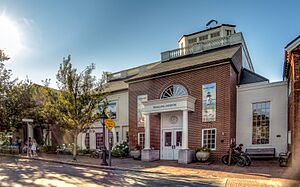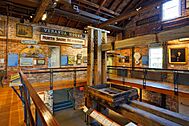Nantucket Whaling Museum facts for kids
 |
|
| Established | 1930 |
|---|---|
| Location | Nantucket, Massachusetts |
| Type | Museum |
The Nantucket Whaling Museum is a cool place to visit in Nantucket, Massachusetts. It's a museum that tells the story of Nantucket's past, especially its history with whaling. The museum is managed by the Nantucket Historical Association. It's their main and most important location.
The museum was updated in 2005. This update connected two older buildings: the 1847 Hadwen & Barney Oil and Candle Factory and the 1971 Peter Foulger Museum. The new design added more space for exhibits and programs. One of the most exciting parts is the Gosnell Hall Whale Hunt Gallery. Here, you can see a huge 46-foot (14-meter) long skeleton of a sperm whale hanging from the ceiling!
The Hadwen & Barney Oil and Candle Factory shows how people used to make spermaceti candles and refine whale oil. You can see a giant lever press that was used in this process. The museum also explains other businesses that grew on Nantucket because of whaling. There are eleven different areas with artifacts and art that show what life was like on Nantucket.
In 2008, the Whaling Museum received a special award called accreditation from the American Association of Museums. This means it meets high standards for museums. They received it again in 2017.
Contents
History of the Museum
Early Days of the Factory
In the mid-1800s, two partners named William Hadwen and Nathaniel Barney ran a business that made whale oil on Nantucket. In 1848, they bought a factory building. This building was made in 1847, just after a big fire swept through the area. It was built in the Greek Revival style, which was popular at the time. This factory was the main part of a group of buildings used for processing oil and making candles. The oil from Nantucket was even used for street lamps in big cities like London and Paris, and for lighthouses along the Atlantic coast!
From Factory to Museum
After the whaling industry on Nantucket ended, the last whaling ship left the island in 1869. The factory building was then used as a warehouse. Much later, it became an antiques shop.
In 1929, the Nantucket Historical Association bought the building. They wanted to use it to display a collection of whaling items. These items were given to them by Edward F. Sanderson, who was a minister. The Whaling Museum officially opened in the Hadwen & Barney Oil and Candle Factory in 1930. It showed off Sanderson's collection of harpoons, lances, and other tools used in whaling. There was even a whaleboat set up as if it were ready for action!
Growing Collections and New Buildings
Over the years, the Nantucket Historical Association kept collecting more items. While the Whaling Museum focused on the whaling industry, other museums on the island showed different parts of Nantucket life.
In 1929, Admiral William Mayhew Folger left money to the Nantucket Historical Association. He wanted a new building to be built in honor of his ancestor, Peter Foulger. This new building, called the Peter Foulger Museum, was finished in 1971. It provided new exhibit halls, a library, and office space.
The Modern Museum
By the early 2000s, the Nantucket Historical Association's library and collections were in their own special buildings. This meant the Broad Street area, where the Whaling Museum was, could be improved. A new museum was designed. It connected the 1847 Hadwen & Barney Oil and Candle Factory and the 1971 Peter Foulger Museum. This new design created a bridge between the two buildings with more space for exhibits and programs.
This is when Gosnell Hall was added, where the huge sperm whale skeleton hangs from the ceiling. The Hadwen & Barney Oil and Candle Factory is now shown as an industrial site. Visitors can learn about the complex process of refining oil and making spermaceti candles. New exhibit areas were also added, including a gallery for scrimshaw (art made on whalebone or ivory) and other decorative arts. There are also changing exhibits about Nantucket life, art, and ideas.
See also






